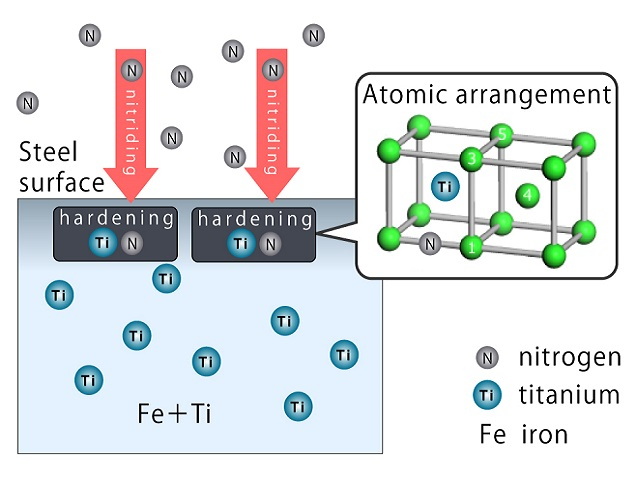Research News
May 20, 2024
- Informatics
Seeking stronger steel, systematic look at 120 combinations of alloy elements provides clues
Calculations consider how a dozen metals such as titanium combine with nitrogen or carbon to form bonds
Stronger steel
Model of stable configuration of nitrogen and titanium in steel of iron-titanium alloy.
Credit: Osaka Metropolitan University

Decarbonization of automobiles not only requires a shift from gasoline engines to electric motors, but also quality steel parts that help the motors run while lessening the weight of vehicles. High-performance steel materials can offer quieter rides and resist the wear and tear from high-speed rotation in motors. To create them, the process of modifying the steel surface with carbon, nitrogen, and alloy elements needs to be optimized.
To understand the interactions between elements in steel, a systematic investigation has been conducted by an Osaka Metropolitan University research group led by Associate Professor Tokuteru Uesugi of the Graduate School of Informatics. The group theoretically calculated 120 combinations of how 12 alloy elements, including aluminum and titanium, interact with carbon during carburization and nitrogen in the nitriding process.
The results showed that when titanium is placed in a specific arrangement, it bonds with nitrogen or carbon, hardening the iron. The group’s analytical data also showed that the alloy element must have a larger metallic radius than the iron atom to bond well.
“Although it was not easy to elucidate the mechanism from the results of numerous calculations, we used multiple linear regression and stratified analysis through trial and error,” Professor Uesugi stated. “These results are expected to contribute to a better understanding of the mechanisms of steel strengthening and improved durability, and to the development of superior materials.”
The findings were published in ISIJ International.
Funding
This work was supported by MEXT Program: Data Creation and Utilization Type Material Research and Development Project Grant Number JPMXP1122684766. Tokuteru Uesugi gratefully acknowledges the financial support provided by the 29th ISIJ Research Promotion Grant, JSPS KAKENHI Grant Number JP23K04422, JST under Collaborative Research Based on Industrial Demand “Heterogeneous Structure Control: Towards Innovative Development of Metallic Structural Materials,” and the Light Metal Educational Foundation.
Paper information
Journal: ISIJ International
Title: Interactions between interstitial and substitutional elements of solute diatomic and triatomic clusters in α-Fe from first-principles calculations
DOI: 10.2355/isijinternational.ISIJINT-2024-062
Authors: Tokuteru Uesugi, Shuji Ashino, Yorinobu Takigawa, Kenji Higashi
Published: April 6, 2024
URL: https://doi.org/10.2355/isijinternational.ISIJINT-2024-062
Contact
Graduate School of Informatics
Email: uesugi[at]omu.ac.jp
*Please change [at] to @.
SDGs
